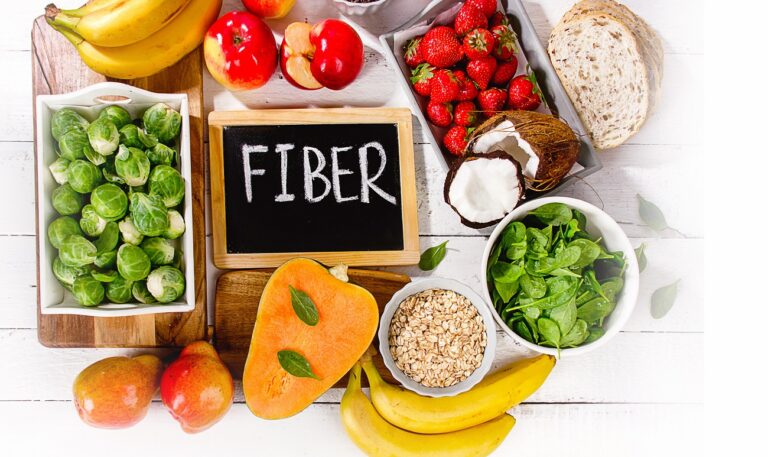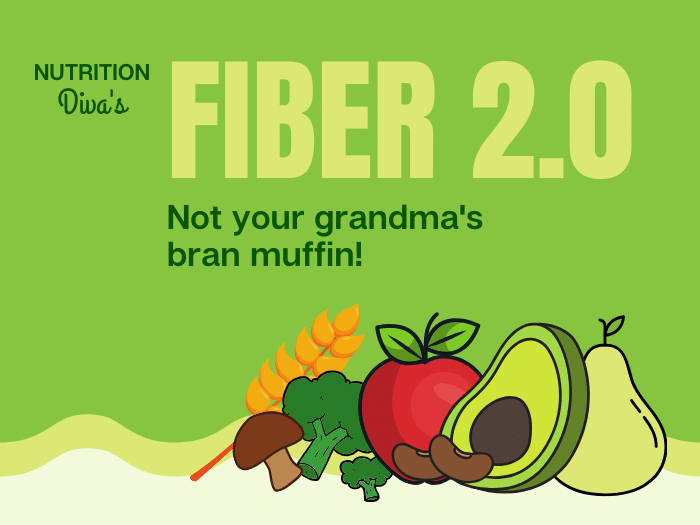Fiber may seem like a somewhat frumpy nutrient, but it is actually one of the hottest nutrition topics right now. That’s partly because fiber plays such a big role in the health and function of the gut microbiota. And anything to do with the microbiome is trending—for good reason!
Fiber 411
The way we define and categorize fiber has also gotten a complete overhaul in recent years. We used to think of fiber simply as “roughage;” the parts of plants that our digestive system could not break down and convert into energy.
The list of benefits attributed to fiber now include reduced inflammation, enhanced immune function, appetite and weight control, enhanced nutrient absorption, better blood sugar control, and Type 2 diabetes prevention.
Dietary fiber was further broken down into soluble and insoluble fiber. Soluble fiber, like that in oat bran, was thought to act like a sponge, soaking up cholesterol and keeping it out of your bloodstream. Insoluble fiber, like that in wheat bran, was thought to work more like a broom, helping to move waste through the system.
We now recognize that fiber does a lot more than soak stuff up and move stuff out. And the list of benefits attributed to fiber has been expanded to include reduced inflammation, enhanced immune function, appetite and weight control, enhanced nutrient absorption, better blood sugar control, and Type 2 diabetes prevention. A lot of this happens via the microbiome: the fiber in our diet affects the number and variety of beneficial bacteria in our gut.
What are prebiotics? In episode 195 of the Nutrition Diva podcast I explain. Listen in the player below.
The fiber story is far more complex (and interesting!) than we ever imagined. Instead of just recommending you add more fiber to your diet in general, we now know that specific types of fiber have different effects. If you’re looking for a particular benefit, you’d want to match your choices to your concern. (And at the end of this article, you’ll find an infographic to help you do just that.)
But first, let’s just get our terminology straight.
Types of fiber
You’ll still see fiber broken down into soluble and insoluble on Nutrition Facts labels. But this is not the only—or even the most meaningful—way to sort or categorize fiber. We now define fiber not just by its solubility but also its viscosity, fermentability, tolerability, and prebiotic activity.
Soluble and insoluble
Soluble fibers dissolve in water. Insoluble fibers do not; stir them into water and they’ll eventually settle to the bottom of the glass.
Viscous and non-viscous
Viscous fibers are soluble fibers that don’t just dissolve in water, they actually form a semi-solid gel.
Fermentable and non-fermentable
Fermentable fibers stimulate the growth of beneficial bacteria in the gut. Fermentable fibers include both soluble and insoluble fibers (although most are soluble).
Prebiotic activity
A prebiotic fiber is a fermentable fiber that has been shown to selectively promote the growth of specific bacteria linked to health benefits. All prebiotics are fermentable fibers. But not all fermentable fibers have been classified as prebiotic.
How fiber is labeled
In addition to these terms describing form and function, there are other designations that have to do with how fiber is regulated and labeled.
Functional fiber
A functional fiber has been extracted from its original food source for use as a supplement or food additive. In order to be classified as a functional fiber, it must have some beneficial effect on health, but that does not necessarily need to be through its effect on the intestinal bacteria. A functional fiber may be soluble or insoluble, viscous or non-viscous, fermentable or non-fermentable.
Intrinsic, isolated, and synthesized
Fiber that’s naturally occurring in food, such as the fiber in whole wheat bread, is considered an intrinsic fiber. Fiber that’s been isolated or extracted from a food source, such as beta-glucans from oats or psyllium husk from psyllium seed, is isolated. Fiber that doesn’t occur naturally in food, such as polydextrose, is synthesized. Synthetic fibers may provide health benefits, or they may be used to improve the texture or other qualities of manufactured foods.
Inulin, for example, has some rather magical qualities in foods. It can drastically reduce the amount of sugar needed to make things taste sweet—without the use of noncaloric sweeteners. (Inulin is sometimes listed on the label as chicory root fiber.)
There’s not much fiber can’t do for us!
Now that we’ve sorted out all the different types of fiber, let’s review the latest research on all the things fiber can do for us.
Regularity
Promoting regularity was once thought of as fiber’s only real benefit. While the list of health benefits has gotten a lot longer, this is still a good one. Both soluble and insoluble fiber play a role. Insoluble fiber, such as from wheat bran, absorbs water from the digestive tracts and adds bulk to the stool. Soluble fibers work more indirectly by increasing the number and activity of beneficial bacteria in the gut. These bacteria and their byproducts also have a stool bulking effect. The most effective types of fiber for promoting regularity are wheat bran and other cereal grains, oat bran, and psyllium husk.
Heart health
Fiber also reduces the risk of heart disease, primarily through reducing LDL cholesterol levels. Soluble fiber is the most effective type for this, but not all soluble fibers are equally effective. The best types are the viscous ones, including beta-glucans from oats and barley, and psyllium husk. On the other hand, Inulin (a non-viscous, soluble fiber) has little effect on cholesterol levels.
Appetite & weight control
Another potential benefit of higher fiber diets is reduced hunger and lower body weight. Soluble, viscous fibers absorb water, form gels, and take up more room in the stomach. Soluble fibers also slow down the speed at which food leaves the stomach and the rate at which sugars enter the bloodstream. Even the extra time it takes to chew foods high in fiber may contribute to increased fullness and decreased food intake. Wheat dextrin, which is a soluble, non-viscous, fermentable, fiber found mostly in supplements has been shown to significantly reduce hunger between meals and reduce food intake.
Not surprisingly, people who consume more fiber tend to weigh less, regardless of what type or source of fiber they consume. Studies have found that increasing fiber intake by 14 grams per day (which, for most people, would mean doubling their daily intake) led to a 10% reduction in calorie intake and modest weight loss. The changes in gut bacteria due to fermentable fiber intake also seem to tip the scale (as it were) toward weighing less.
Blood sugar control and type 2 diabetes risk management
The evidence for fiber’s ability to modulate blood sugar and Type 2 diabetes risk is not as unanimous. People whose diets are higher in insoluble fiber have a significantly reduced risk of developing Type 2 diabetes. But adding fiber to the diet does not reliably improve blood sugar control in people with Type 2 diabetes. It’s possible that other nutrients in those higher fiber foods are partially responsible for the effect. (Another argument for getting our nutrients from whole foods instead of supplements.)
Gut inflammation and immune Function
Certain fibers—in particular, the fermentable, prebiotic fibers—help boost the gut’s immune function. The good bacteria promoted by the fermentable fibers crowd out pathogenic bacteria and prevent them from taking hold. Soluble, non-viscous fibers may also help alleviate gut inflammation, including irritable bowel syndrome.
Note: Fibers that are fermented more quickly, such as FOS (fructo-oligosaccharides), may cause more gas and bloating than fibers that are fermented more slowly. Eating them in smaller amounts may be preferable. While these types of foods and fibers can cause discomfort in anyone (especially if consumed in large quantities), it can be particularly problematic for people with IBS. The low FODMAP diet, which I’ve discussed on the podcast before (listen to episode below), avoids (among other things) foods that contain a lot of these highly fermentable fibers and can be extremely helpful for people with IBS and other inflammatory bowel conditions.
Do you get enough fiber on a low FODMAP diet? Listen to my podcast episode on that in the following player as you read on.
Nutrient absorption
I’ve saved one of the most interesting benefits for last. Fermentable fibers that don’t qualify as prebiotics can still provide benefits by enhancing the absorption of calcium and other minerals from the large intestine.
Clearly, there’s more to fiber than just bran muffins.
As we learn more about the many different types of fiber and all the ways in which they affect our health, I expect that we’ll see more supplements and functional foods that target specific concerns with specific types of fiber. But I still think the best way to leverage the myriad benefits of fiber is to eat a wide variety of fiber-containing foods. Not just one whole grain but lots of different kinds of whole grains. Not just three or four super fruits or vegetables but a cornucopia of produce. And don’t forget all the legumes, pulses, nuts, and seeds!
Not only will this expose you to a wide variety of fiber types and benefits but also to the other nutrients that these high fiber foods contain. And the more of these foods you eat, the less room you’ll have on your plate and in your stomach (and maybe, one day, in your affection) for processed and nutrient-poor foods that aren’t doing nearly as much for you.
Fiber 2.0 Nutrition Guide—What to Eat for Specific Health Benefits
Click the image below to access our fiber infographic. Please include attribution to Quick and Dirty Tips when using this graphic.





